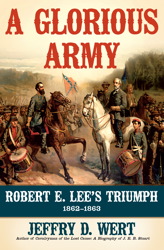A Glorious Army: Robert E. Lee’s Triumph, 1862-1863
 Robert E. Lee and his vaunted Army of Northern Virginia are often remembered as the best army the South was able to put in the field. Their storied marches, leaders, and victories have become the stuff of legend. Lee was able to take an army, that was in reality a conglomeration, from the back door of Richmond to nearly the front porch of Washington. He and “Stonewall” Jackson defeated a vastly superior Army of the Potomac at Chancellorsville, opening the gates again toward northern soil.
Robert E. Lee and his vaunted Army of Northern Virginia are often remembered as the best army the South was able to put in the field. Their storied marches, leaders, and victories have become the stuff of legend. Lee was able to take an army, that was in reality a conglomeration, from the back door of Richmond to nearly the front porch of Washington. He and “Stonewall” Jackson defeated a vastly superior Army of the Potomac at Chancellorsville, opening the gates again toward northern soil.
In his latest work, author Jefferey Wert examines Lee’s Army in its time of its greatest successes. Wert, picks up the story as Lee takes over command from Joseph Johnston on the Peninsula. Readers are taken from battlefield to battlefield with Lee and his men. Along the way, Wert explores the commanders and command structure within the Army of Northern Virginia.
Wert keeps the time period of the book relatively compact. The author examines the time of Lee’s greatest success and ends around Gettysburg, at the time of one of Lee’s greatest defeats. Although we visit many of the famous battlefields in the east, we do not explore each in great detail, which would bog down a work like this.
Through the work, Wert is able to weave a story of how and why Lee’s army went from a powerful war machine to a nearly broken instrument of war at Gettysburg. The losses within the high command coupled with the losses at the brigade and regimental level all compounded on themselves to breakdown the cohesion of the Army of Northern Virginia.
Wert also weaves in the thoughts and conclusions of many other prominent historians. It is a great way to see what the author is saying, while comparing and contrasting the thoughts of others into one volume.
A Glorious Army: Robert E. Lee’s Triumph, 1862-1863 is a great addition to the recent works on the Army of Northern Virginia. It is a refreshing take on Lee and his fighting men. Many serious students of the Eastern Theater may find the book a rehash of what other authors have said, while those not so familiar with the east or Lee’s Army will find this a great one-stop read to bring them up to speed on Lee’s success and failures as a commander. In the end, most students of the war will find this well-written one-volume work a worthwhile read.